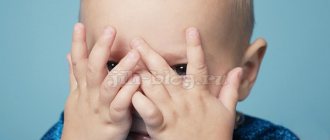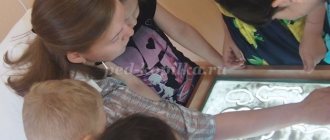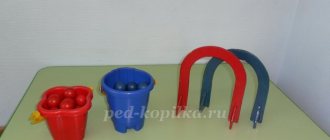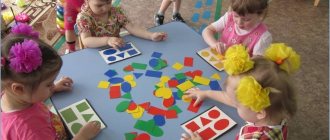We learn to sort, reinforce the concepts of “big-small”:
The essence of the game: to consolidate in the child’s mind that there are large and small snowflakes in front of him, to sort the snowflakes: large ones into a large “house”, and small ones into a “small” house.
For the game you will need snowflakes of two sizes - large and small (they can be drawn on paper).
To attract the baby's attention and create a “surprise moment,” put on a small show. In front of the child's eyes, with a light movement, throw snowflakes into the air so that they spin beautifully and fall to the floor, attract his attention with your voice: “Oh! Snowflakes are flying! How beautiful they are!”
Carefully examine the snowflakes with your child, draw his attention to the fact that some snowflakes are “so big!”, while others are “so small!”
Prepare “ houses ” for snowflakes in advance - one large and one small (for example, a large plate and a small saucer). Tell your child that the snowflakes want to be taken to the houses - “big snowflakes will go to this big house, and small snowflakes will go to this small house.”
To make it more interesting, snowflakes can be delivered on a truck or carried on a tray, or come up with another unusual way of delivering snowflakes.
What if the child doesn't want to sort?
Perform the sorting yourself, while accompanying all your actions with speech, do it in such a way as to attract the child’s attention. Even this method of completing the task will be beneficial: firstly, the concept of “big-small” will be better fixed in the child’s mind, and secondly, children are big conservatives, and often reject some games and tasks because they seem too “ unknown." It is quite possible that after watching the mother perform the sorting several times, the child will want to “repeat after the mother” next time and will perform all the actions himself.
Educational field: “Cognitive development”.
Tasks.
To develop children’s ability to find objects of the same shape in the environment (circle, triangle, square).
Continue to introduce children to the signs of spring, encourage them to answer the teacher’s questions, repeat individual words and simple sentences after him.
Teach children to draw an image of the sun with a felt-tip pen, draw rays. Fix the yellow color.
Progress of the lesson
Educator:
The sun looks from the sky
And so pure
Good radiant!
If only we could get him
We would kiss him.
The teacher draws attention to the board where there is an image of a large sun with rays and other color illustrations about spring (icicles hanging from roofs, black paths, birds on branches).
Educator:
The sun greets us. Animals, flowers and little children love it when it’s warm, and the sun gives us warmth. It warms us with its rays. The sun is shining brightly because spring has come.
The teacher asks what time of year it is. Children answer one at a time, and then answer in chorus.
The teacher draws the children's attention to the fact that the snow melts on the roofs in the spring and icicles appear. It melts faster on roads and paths. There's less of it there. The snowdrifts turn black and settle. Birds fly in and sing loudly.
The teacher draws the children's attention to the fact that someone is snoring loudly in the house. This is a little bear sleeping, he needs to be woken up. The teacher and the children wake up the bear cub.
Educator:
Children, tell me which teddy bear? Big or small? Children answer (2-3 children).
Educator:
What kind of bed does the bear cub have? Big or small? The teacher encourages them to answer (asks two or three children).
Educator:
The teddy bear is small and the bed is small. Mama bear woke up and went to get food. And I forgot to wake up the little bear. So he sleeps drowsy. This way you can sleep for a long time and sleep through a lot of interesting things.
Physical education lesson about birds
(musical soundtrack).
Educator:
The bear is small and loves to play. Let's take him to kindergarten and teach him to play our games. And here is the magic path.
(The teacher lays out a path of linoleum circles.) The children and the bear cub walk along this path. Hidden in the last circle was a little man with eyes and a mouth. Children, together with the teacher, examine the shape (circle).
Educator:
The little man is very upset; he cannot find round objects. Let's help him find these items in our group.
Children and the teacher find objects and put them in a hoop where a circle man is located.
The teacher pays attention to what figure the found objects resemble.
The same thing happens with a triangle and a square.
If there is difficulty, the teacher searches with the children for objects of the required shape in the group environment.
Educator:
Spring is coming to us
Quick steps
And the snowdrifts melt under her feet,
Black thawed patches are visible in the fields,
You can see very warm feet in spring.
Educator:
Guess who helps spring. Round, bright, affectionate, with rays.
Children answer that it is the sun (individual answers).
Educator:
Let the children draw a sun with rays for the little bear as a souvenir.
The children sit at the tables.
The teacher shows on the easel how to draw the sun with rays.
Children draw the sun with rays in the air.
The teacher distributes sheets of white paper and yellow markers.
Children draw. The teacher comes up and helps those who cannot.
The guys give drawings to the bear cub. He says goodbye to the children and goes to look for his mother.
Musical pause.
♪♪♪ Let’s dance with the baby to the Zheleznovs’ song “Together with us” (“You clap with us - clap and clap”).♪♪♪
You can listen to the song here.
We perform the movements according to the meaning of the song (they are very simple and obvious).
After you have listened to the song, play a musical instrument with your child .
Turn on any tune that you like, take a few musical instruments that you have at home, and start playing: two minutes on one instrument, two minutes on the second, etc. It is not necessary for the child to get into tune, the process itself is important.
What musical instruments should you offer your child, and what to do if there are none in the house?
You can use special children's musical instruments (tambourine, drum, maracas, spoons, etc.). But if there aren’t any in the house, it’s okay; you can read about what musical instruments are found in any home here: link . (to be honest, my daughter and I most often play “home” musical instruments, and Dasha really likes it. Of the purchased instruments at home, we only have a tambourine and a pipe; it seems to me that other instruments for simple non-professional home music playing need not be bought – after all, there will always be substitutes for them at home).
“Pour the snow over” - development of motor skills.
The essence of the task: the child is offered a bowl filled with “snowball” - semolina, and an empty glass. Mom shows how to pour the cereal with a spoon and asks the baby to do the same. (It is advisable to choose the most beautiful and bright containers that you have in your home - bright and beautiful jars and cups are very attractive to kids).
What does this activity develop?
The game develops the child's fine motor skills and teaches how to use a spoon. The development of fine motor skills in children directly affects the development of speech and overall mental development.
Introductory part
Lesson topic: We will go to visit the bear.
Purpose of the lesson: To involve children in joint activities to develop cognitive activity.
Tasks:
- Create an emotional mood, activate children's speech development and vocabulary.
- Strengthen the ability to distinguish between sizes: large, small.
- Practice the ability to correlate the 3 primary colors (yellow, green, red).
- Develop attention, memory, auditory perception.
- Develop cultural, hygienic and self-care skills.
- Cultivate a friendly attitude towards each other.
- Prevent fatigue; create conditions conducive to the development of physical activity.
Dictionary:
- small;
- big;
- cones;
- mugs;
- saucers;
- colors: yellow, red, green.
Material and equipment:
- Teddy Bear toy;
- 2 baskets with cones (large, small);
- colored mugs and saucers;
- laptop;
- audio recordings.
Musical development.
♪♪♪ Let’s dance to the wonderful song “Snow-Snowball” by E. Makshantseva. ♪♪♪
You can listen to the song at this link.
If the child’s age is closer to 2 years, you can try the following movements:
Snow-snowball, snow-snowball, (Clench and unclench our fists.)
It creeps along the path. (We smooth out the path with our hands.)
Snow-snowball, snow-snowball, white blizzard, (Again we clench and unclench our fists.)
Snow-snowball, snow-snowball, (Clench and unclench our fists.)
The paths are covered in snow, (“Smooth out” the path.)
Snow-snowball, snow-snowball, (Clench and unclench our fists.)
Melts on the palm. (Turn your palm up and look at it.)
We will make snowballs, we will play together, (“We make” snowballs)
And we happily throw snowballs at each other. (“Throwing” snowballs)
We are warm in the yard, (cover our ears - make a hat)
Ears are not frozen. (head movement “no-no”)
We will roll the snow into a huge white lump. (motor movement, the diameter of the circle constantly increases and at the end we show a large circle with our hands.)
If these movements are too complex for a child, you can simplify them (perform only part of the movements, skip complex ones), or come up with your own snow dance (spinning around the room with Christmas tree tinsel in your hands, jumping, clapping your hands, stomping your feet, etc.) .






